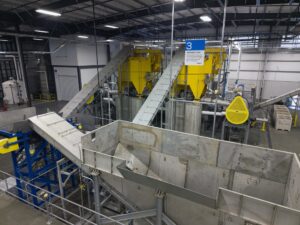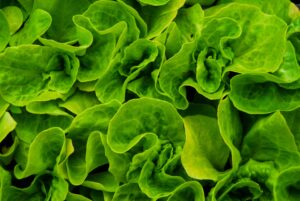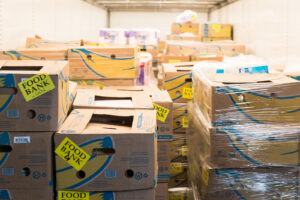November 25, 2024
In this post: Science Study Summary | Concerns About Implementation Timeline | Concerns About Processing Capacity | Concerns About Study Data | Conclusion
Summary: A recent study published by the journal Science claims that with the exception of Massachusetts, organic waste bans have had little effectiveness in reducing overall waste. A closer look at the implementation timelines, infrastructure capacity, and other details reveal that there is insufficient data to conclude that the bans are not effective. States need more time for implementation, and a mosaic of solutions, to achieve a meaningful reduction in organic waste.
Are organic waste bans actually effective at keeping wasted food out of landfills? A new study published in the journal Science took a look at five U.S. states where these bans have been signed into law and concluded that only Massachusetts has been effective in reducing its wasted food. However, a closer look at the timeline of the dataset researched and other key points of the argument reveal a much more complex picture and call into question the validity of the study, including how geopolitical issues such as China’s “National Sword” policy have impacted waste volumes within the U.S.
Specifics of the Science Organic Waste Study
Over the past ten years, from 2014 to 2024, ten US states have enacted organic waste bans to reduce the amount of unsold and uneaten food being landfilled to varying degrees. The Science study evaluates the first five US state level bans “where data is available” until 2018 to avoid overlap with the COVID-19 pandemic: California (AB 1826), Connecticut (CGS Sec. 22a-226e), Massachusetts (310 CMR 19.000), Rhode Island (23-18.9-17), and Vermont (ACT 148). According to the parameters of the study, researchers claim that Massachusetts has been the most successful at enacting an organic waste ban, which gradually achieved a 13.2% reduction, and should be used as “a benchmark for success.”
Concern #1: The Implementation Timeline of State Organic Waste Bans
In reviewing the Science study, one key point of concern is the timeline of when each of the five states implemented their respective organic waste legislation. The study makes assessments during a timeframe when the states that are being studied had varying degrees of implementation. However, each state’s food waste laws have been implemented on staggered or delayed timelines, some with contingencies that make gathering impact data much more complex. Here’s a closer look, state by state in chronological order:
- Vermont: ACT 148 was passed into law in 2012 and went into effect in 2014, yet the bill was only applicable to wasted food generators that generate over 104 tons of wasted food residuals per year. The law staggered implementation over the course of six years to allow smaller generators time for proper implementation and adoption of new diversion programs.
- Massachusetts: Massachusetts’ rule banning organic waste went into effect in 2014 for wasted food generators that were generating a ton of wasted food per week. In 2022, the requirement expanded to include generators that are generating half a ton of wasted food per week.
- Connecticut: The ban took effect in 2014 for each commercial food wholesaler or distributor, industrial food manufacturer or processor, supermarket, resort or conference center that is located not more than twenty miles from an authorized source-separated organic material composting facility and that generates an average projected volume of not less than one hundred four tons per year of source-separated organic materials. In other words, a waste generator’s participation was dependent on whether there was an authorized source-separated organic material composting facility open that would trigger compliance with the law. The ban had staggered implementation for various types of generators, finally requiring generators that produce twenty-six tons per year of source-separated organic material comply beginning in 2022.
- California: AB 1826 required businesses that generate eight or more yards of cubic waste per week to arrange for recycling services of organic waste, beginning on April 1, 2016. Over the implementation period, the program increased the number of generators needing to comply by lowering the generating threshold over a period of years. In 2020, the law required any businesses generating at least two cubic yards per week to arrange for organics recycling. Simultaneously, with the passage of SB 1383 in 2016, the state set forth goals to reduce organic waste disposal 75% by the year 2025 and to rescue edible food by at least 20% of the currently disposed surplus food by 2025. After numerous delays, including a multiyear rule-making period, pandemic-related delays, and funding constraints in January 2022, the final regulations went into effect requiring organic waste generators to comply with local requirements by either using the local organics collection service, or self-hauling in a compliant manner.
- Rhode Island: § 23-18.9-17 went into effect in January 2016, and similar to Connecticut’s law, was contingent upon a waste generator’s proximity to an authorized facility with the capacity to accept their material: starting in 2016, waste generators producing more than 104 tons per year of organic waste material and were located no more than 15 miles from an authorized composting or anaerobic digestion facility with available capacity to accept their material. In 2018, the requirement expanded to include generators who were 52 tons of organic waste per year or more.
With these staggered timelines, contingencies, and issues with capacity processing infrastructure, nearly all of the five states highlighted in the Science study are still in the process of ramping up implementation of their respective bans and giving waste generators the ability to comply, yet the study only looked at the effectiveness of these bans through 2018. Therefore, concluding that food waste bans are ineffective is highly premature, if not counterproductive to the goal of reducing wasted food.
With nearly all gives states highlighted in the Science study still in the process of ramping up implementation of their respective bans, concluding that the food waste bans are ineffective is highly premature, if not counterproductive to the goal of reducing wasted food.
Concern #2: Infrastructure for Implementing State Organic Waste Bans
As mentioned above, one key barrier to addressing implementation in several states is access to processing infrastructure that can serve commercial waste generators, which these bills target. In some cases, the bans were implemented to incentivize the development of processing facilities and ensure a baseline feedstock. Such is the case in California, Connecticut, and Rhode Island.
In California, Calrecycle estimates that the state will need approximately 50 – 100 new or expanded organic waste recycling facilities to annually recycle an additional 20 – 25 million tons of organic waste. Much of the new infrastructure will likely be the result of private investment, although some jurisdictions are only just beginning to make the investment in their own infrastructure.
Connecticut is another state that does not yet have the infrastructure to process the total volume of wasted food being produced in the state. Connecticut’s Department of Energy & Environmental Protection (DEEP) website states, “Based on the 2015 Statewide Waste Characterization Study, it is estimated that 22.3% of the solid waste stream in Connecticut consists of food – that’s nearly 520,000 tons per year of food being thrown away […] If all the food residuals that are generated in Connecticut were to be collected, the state would not have adequate capacity at our currently permitted facilities to handle the volume.” As further stated on DEEP’s website, the intent of the law was to guarantee some level of feedstock for potential composting and anaerobic digestion facilities to provide the incentive for developers to build recycling facilities in Connecticut. As of 2024, Connecticut has one operating commercial-scale anaerobic digestion facility with the capacity for 360 tons per day of organics, three AD facilities have been permitted but not constructed, three commercial composting facilities processing approximately 6,500 tons of wasted food per year, and one on-farm anaerobic digester that, once permitted, will receive 100 tons per day of food scraps.
Rhode Island, the state with the smallest land area and highest population density, generates an estimated 220,000 tons per year of wasted food. The state has a goal for 80% diversion, or roughly 174,000 tons per year, but their infrastructure was “practically nonexistent” prior to the ban. Rhode Island’s ban has spurred development of new infrastructure for anaerobic digestion and composting that will be able to process approximately 48,000 tons per year once fully operational.
In contrast to these other states, Massachusetts already had substantial organics processing capacity by the time its organic waste ban was enacted in 2014. According to Biocycle, “Starting from a base in 2011 of 23 permitted facilities with about 100,000 tons per year of capacity, by 2014, Massachusetts had added an additional 120,000 tons per year of permitted capacity — with 26 additional facilities receiving permits and ongoing facilities expanding the quantity of food waste accepted.”
While the study touts the available composting infrastructure as one of the reasons that Massachusetts should be considered a standard bearer, we see it differently: volume of waste diverted is a lagging metric, while capacity built is a leading metric. The fact that states like Rhode Island and others in the study are increasing their capacity to meet the demand means that the legislation is effective, and is indicative of the lagging metric to follow, e.g., that the volume of waste diverted will increase as capacity grows.
The fact that states like Rhode Island and others in the study are increasing their capacity to meet the demand means that the legislation is effective.
What the “capacity built” metric should look like in each state is also more nuanced than the Science study would have readers believe. The study seems to imply that composting is the most viable solution. Yet all composting, including industrial composting, has to balance food feedstock with other organic inputs like yard waste (typically a 30:1 ratio) to achieve the correct nutrient balance for the compost byproduct. In addition, many commercially generated food sources have an extremely high moisture content and contain a significant level of microplastic, metal, and glass contaminants in their feedstock stream. Most existing compost facilities are not permitted to accept commercially generated food material without having expensive processing equipment to remove water and harmful contaminants that would be hazardous to soil health. This means that in order to effectively manage the increased volume of food waste as states adopt waste bans, depackaging and processing capacity need to be developed. As long as there is a ceiling to the amount of organic waste that a composting facility can accept to ensure the quality of their compost, there will be a need for other solutions such as anaerobic digestion to process organic waste. Composting alone will not be able to adequately handle the increased demands on the system. This is all the more true when we take into consideration the nuances of a state and jurisdiction’s geography, agriculture, population density, and food marketplace.
Concern #3: Evaluating Organic Waste Ban Success Based on Total Waste Volumes
Considering the two concerns outlined above, we find it unreasonable to claim that organic waste bans were ineffective when:
- They weren’t in full effect during the measured time period,
- There is insufficient data on tons diverted to determine whether they were effective because the laws weren’t in full effect,
- The bans were implemented, in part, to drive innovation and processing capacity to ensure that the infrastructure was in place to address the problem, and there is evidence that the processing capacity is significantly increasing as a direct result.
Since the timelines for implementation and the processing capacity are different in each state, and the data is incomplete, the more accurate conclusion would be that state-level organic waste bans take time to implement, not that they are ineffective.
Furthermore, as noted by ReFED, the study assesses total disposed waste rather than just the organic fraction. Total disposed waste doesn’t tell the whole story of the effectiveness of a state’s organic waste ban because there are important variables to consider:
- Other waste streams, including recyclables: There are many waste streams that contribute to total waste volume, from textiles to technology. Organic waste may have been declining slowly, but did other waste streams see a significant increase? We don’t know from the limited data available to study. For example, during the implementation of China’s “National Sword” policy, announced in July 2017 and fully in effect in January 2018, China prohibited the import of 24 recyclable commodities (including many plastics), increased the purity requirements for recyclable materials, and reduced the number of licenses available for those to import waste. A 2022 study from researchers at the University of Buffalo found that after China implemented its National Sword policy, the quantity of plastic landfilled in the U.S. increased by 23.2%. Without anywhere else for recyclable material to go, the country’s municipal landfills swelled with recyclable material.
- Aging infrastructure: The limited capacity of landfills and other waste processing facilities such as incinerators regularly impact the available data of total waste volumes that jurisdictions report. Although this example falls outside of the studied timeframe, an incinerator in Connecticut closed in 2022, increasing the total volume of waste in landfills in states as far away as Pennsylvania and Ohio.
- Exporting waste: As older waste infrastructure like incinerators and landfills close, states are beginning to ship their waste out of state. According to a report from the Congressional Research Service, “Waste imports have grown significantly since CRS began tracking them in the early 1990s, and now represent 24.2% of the municipal solid waste disposed at landfills and waste combustion facilities. In the last 10 years, reported imports have increased 170%. Pennsylvania remains, by far, the largest waste importer. The state received more than 9.1 million tons of MSW and 1.4 million tons of other non-hazardous waste from out of state in 2003. Most of this waste came from New York and New Jersey.” A state’s total waste volume may be declining, but is it because of the organic waste ban or because of where they’re exporting their waste? Are other states’ total waste volumes increasing due to closures in states hundreds of miles away? Again, this data is not always readily available, and difficult to accurately ascertain for this study.
Organic Waste Bans Do Work, But They Won’t Be One-Size-Fits-All
We know firsthand from working with our customers and policymakers in several states that effectively reducing wasted food is a complex effort that takes time — time to shape actionable policy, time to implement it at scale, and time to develop the necessary infrastructure capacity to handle the increased volume. What works in Massachusetts won’t necessarily work in California, or even in other neighboring states in New England.
While there are a variety of available methodologies to assess results, one thing is certain: studying the results in states where a policy has hardly even begun to go into effect can have adverse policy consequences in states that haven’t begun to take this issue on. What will policymakers do in new states that are only just beginning to consider new organic waste diversion laws? If they lack a full understanding of this study’s scope, then they might think twice about even considering a new organic waste policy. As a result, they might miss a major opportunity to address one of the more far-reaching impacts on climate change.
As policymakers and waste generators consider how to reduce wasted food in their state and maximize the effectiveness of their diversion programs, here are our recommendations:
- Get involved with your state’s food waste legislation and suggest a variety of policy solutions to tackle the issue. Our Food Waste Legislative Tracker, launched in partnership with the Zero Food Waste Coalition and Harvard Law School Food Law and Policy Clinic, provides an overview of wasted food prevention, food rescue, and food waste recycling bills in each state.
- Support legislative or regulatory updates that allow businesses of all sizes to choose the diversion option that is the most cost-efficient, least carbon intensive, and best fits their needs.
- When selecting a diversion partner, choose one that prioritizes waste prevention through source reduction and preservation, as well as food recovery. Edible food should go to the people who need it most; only non-donatable and inedible food should be recycled.
- Choose a diversion partner that can accept and responsibly manage packaged foods. This will result in even more food being processed that would have otherwise been landfilled and greatly reduce the likelihood of microplastics, metals, and glass contaminating compost and soil amendment products.
- When food cannot be sold or donated and must be recycled, make sure that anaerobic digestion is part of the suite of solutions, not just compost alone, to achieve maximum diversion and optimize the carbon negative energy capture from organic material.
- Partner with an organization that has a scalable solution with nationwide processing infrastructure, as well as nationwide policy support to help you navigate compliance.
- Most importantly, choose a partner with proven solutions, and is trusted in the food industry.
About Divert, Inc.
Divert, Inc. is an impact technology company on a mission to Protect the Value of Food™. Founded in 2007, the company creates advanced technologies and sustainable infrastructure to address wasted food, driving social and environmental impact. Divert provides an end-to-end solution that leverages data to prevent waste, facilitates edible food recovery to serve communities in need, and converts unsold food products into renewable energy. Through this integrated approach – Prevent, Provide, Power™ – the company works with over 7,200 customer locations across the U.S. to reduce wasted food and positively impact people and the environment. Its customer base spans across industries and includes five Fortune 100 companies. For more information on Divert, Inc., please visit please visit www.divertinc.com and follow the company on LinkedIn, X, Threads, Instagram, Facebook, and YouTube.



